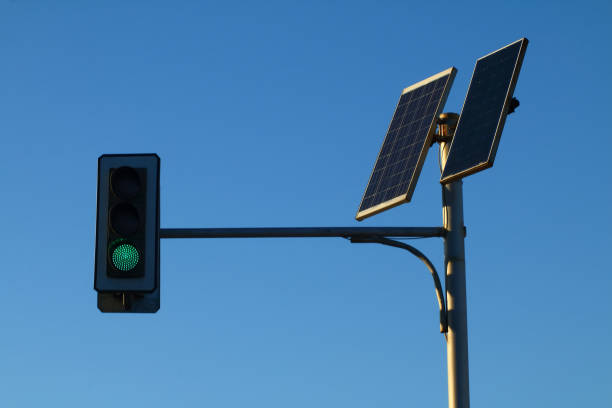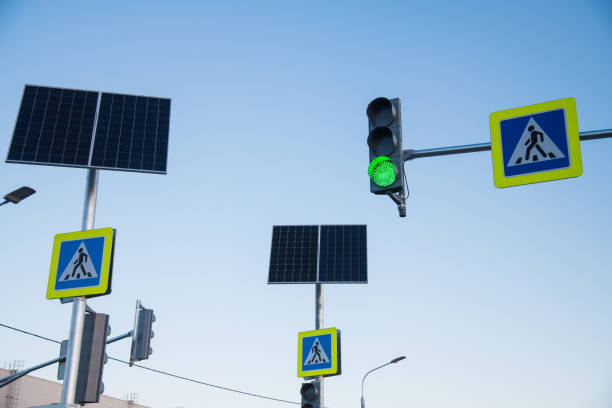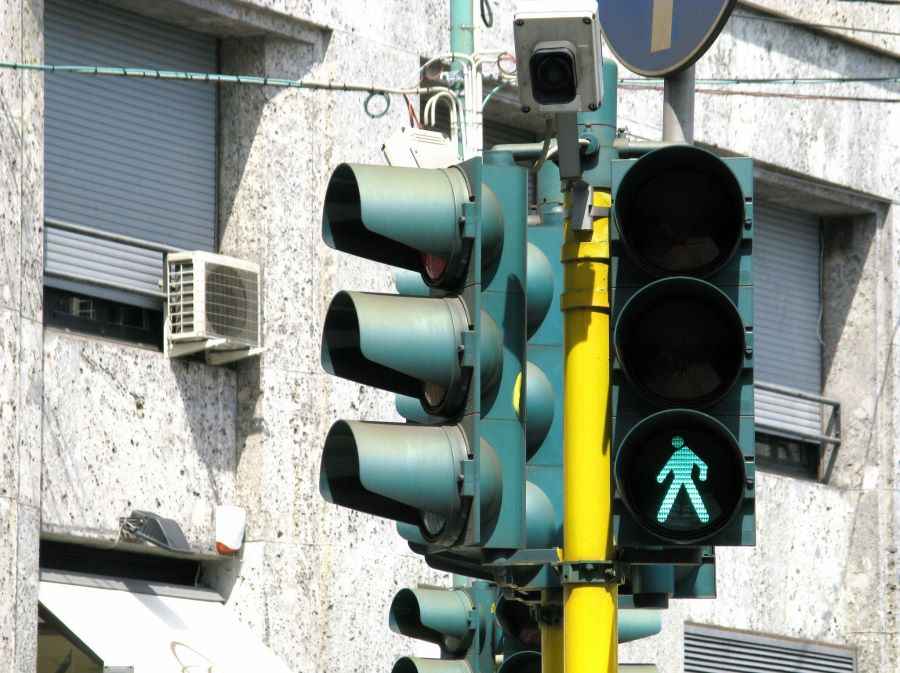Solar signal lights are a good choice for traffic control offices. It saves energy and money, and they are environmentally friendly. Solar lights can be used to power traffic signal lights and hazard signs.
How does solar signal light work? Solar signal lights work by collecting energy from the sun through solar panels. The panels charge a battery, which powers the lights during the night or on cloudy days. LED lights, which are highly efficient and durable, are commonly used in solar Traffic signal lights.

Solar Signal
Solar signal lights offer a number of benefits over traditional traffic lights, including:
- Sustainability: Solar signal lights do not produce any emissions, making them a green and sustainable way to control traffic.
- Reliability: Solar signal blinkers can continue to control traffic even in remote areas because they are unaffected by power outages.
- Cost-effectiveness: Solar signal lights can save money on electricity costs over the long term.
- Ease of maintenance: Solar signal lights are relatively easy to maintain as they do not require any electrical wiring.
If you are looking for a sustainable and reliable way to control traffic, solar signal lights are a good option to consider.
Solar signal lights 101
If you’re on the lookout for a more environmentally friendly and sustainable alternative to traditional road blinker lights, then solar signal lights are definitely worth considering! The sun provides the power for solar signal lights. Solar signal blinkers use photovoltaic panels to collect sunlight and store the energy in batteries. The batteries power the lights at night, emitting bright and visible light.
Solar-powered lights are a safe, sustainable solution for road safety. They’re reliable during power outages, eco-friendly, and great for emergencies and remote locations.
Using solar signal lights for road safety is both practical and eco-friendly. Solar signal lights are affordable, durable, and easy to install. They do not require complicated wiring or electricity bills.
Applications of Solar Signal Lights
Solar signal lights, also known as solar blinkers or road blinker lights, have numerous benefits and are widely used across various industries and sectors. Traffic signals are one of the most common applications of solar blinker signal lights.
They help guide drivers effectively, ensuring smooth and safe traffic flow by using solar-powered LED blinkers. Additionally, construction sites use solar light signals to enhance worker and equipment visibility. It also provides a safer working environment.
Railway crossings also rely on solar traffic Signal blinkers serve as warning signals, alerting drivers and pedestrians to approaching trains and preventing accidents. The diverse and impactful applications of solar signal lights benefit sectors such as transportation, construction, and railway operations.
How to Install Solar Signal Light and Maintenance
Solar signal lights enhance road safety in an eco-friendly way. Planning is crucial for installation, including selecting the right location for visibility and sunlight accessibility.
The light fixture should be mounted securely, ensuring that it is level and stable. Proper wiring connections should be made, and any exposed wires should be adequately protected. Adequate testing should be conducted to ensure that the solar traffic Signal blinkers is functioning correctly. Maintenance of these lights is essential for optimal performance. Inspect regularly to keep light fixtures, lenses, and solar panels clean and undamaged.
It is important to keep your solar panels free from any obstructions such as dust, leaves, and bird droppings. Troubleshoot issues and conduct maintenance and battery checks to extend the lifespan and maximize the efficiency of solar road safety lights.

Solar Signal
What are the challenges, and how do we fix them?
- High initial cost: Solar signal lights can be more expensive than traditional traffic signals. However, the long-term savings on energy costs can offset the initial investment.
- Lack of sunlight: Solar signal lights need sunlight to generate electricity. In areas with long winters or cloudy days, the solar panels may not produce enough power to keep the lights running. Utilizing a battery backup or positioning the lights in areas with more sunlight can both solve this problem.
- Weather damage: Harsh weather conditions like rain, snow, and wind can harm solar signal lights. Using robust materials and positioning the lights in protected areas can stop this.
- Technical problems: Solar signal blinker lights can experience technical problems, such as battery failure or solar panel damage. Regular maintenance and the use of high-quality components can prevent this.
Solar signal lights are interesting and could save energy and money. There are some obstacles to overcome before they can become widespread solutions.
Comparison with Traditional Signal Lights
Solar signal lights, also known as solar blinkers or solar blinker lights, offer a modern and eco-friendly alternative to traditional road blinker lights.
When comparing and contrasting solar signal lights with their traditional counterparts, several advantages and disadvantages can be identified.

These solar lights save carbon emissions and electricity expenses over time. They use LED blinkers that last longer and use less energy.
Unlike standard signal lights, they may not work well in low-light or overcast conditions.
The Future of Solar Signal Lights
The future of solar signal lights looks promising, with ongoing advancements in technology and continuous innovations in the field. Solar traffic Signal blinkers, also known as solar blinkers or road blinker lights, have seen significant improvements in recent years.
The development of more efficient solar panels and long-lasting LED bulbs has contributed to the effectiveness and performance of solar signal lights. These advancements ensure that the lights can produce bright and clear signals, even in overcast or low-light conditions.
Thus, solar signal lights may become widely used. Solar light signal are becoming more popular owing to their affordability and environmental friendliness. They’re perfect for signaling since they don’t need electricity.

Solar Signal
FAQ
How do solar lights know when to come on?
Solar lights charge batteries using sunlight from a solar panel. The lights have photoreceptor cells to measure ambient light. When it gets darker outside, these cells trigger the solar lights to switch on by activating the circuitry of the light.
Where can one buy solar sign lights?
Solar sign lights can be purchased from various sources. Many home improvement stores and lighting specialty shops carry a selection of solar lights.
Furthermore, numerous online retailers, such as Amazon, also provide an extensive array of solar lighting options, including solar traffic signal lights and solar warning lights.
It is also common to find reputable manufacturers of solar traffic signals and lighting equipment offering their products directly to consumers.
Read Also: Solar Powered Security Light: How To Stay Safe And Eco-Friendly With Solar Security Light?
Why does my solar light stay on in the daylight?
If your solar light stays on in daylight, it may be a photoreceptor issue. This sensor turns off the solar light when it senses enough light; however, if it’s broken or blocked, it may not work. A light control controller problem might possibly be at fault.
Where is the sensor on my solar light?
Your solar light’s photovoltaic or photoresistor sensor is usually on top of the light, near or on the solar panel. This is to efficiently sense the amount of sunlight (or lack thereof) and hence manage the operation of the light suitably.
How do solar traffic lights work?
Solar traffic lights use solar electricity only. Photovoltaic cells in these lights capture solar energy throughout the day, which is stored in rechargeable batteries for use at night. Solar traffic lights turn the signal light on and off like traditional traffic signals.

What is the lifespan of a solar light?
Solar lights last 2–10 years. LEDs are more robust and last over 10 years. However, batteries may need changing every 3–5 years. With good care, solar panels may last 30 years.
Choose a sunny place, clean them often, and avoid direct sunlight during the hottest portion of the day.
In conclusion, the article has thoroughly discussed the integral aspects of solar signal lights and solar traffic blinkers. It re-emphasized their profound benefits, such as sustainability, cost-effectiveness, and user friendliness, and their potential to revolutionize various industries.
The evolution and future trajectory of these solar-powered devices were also analyzed, positing their impending dominance in traffic management systems, among other applications. Undoubtedly, the proliferation of these solar signal lights and blinkers holds promise for an eco-friendly and efficient future.
Read Also: Here Is The Secret: How Long Do Solar Lights Last?








